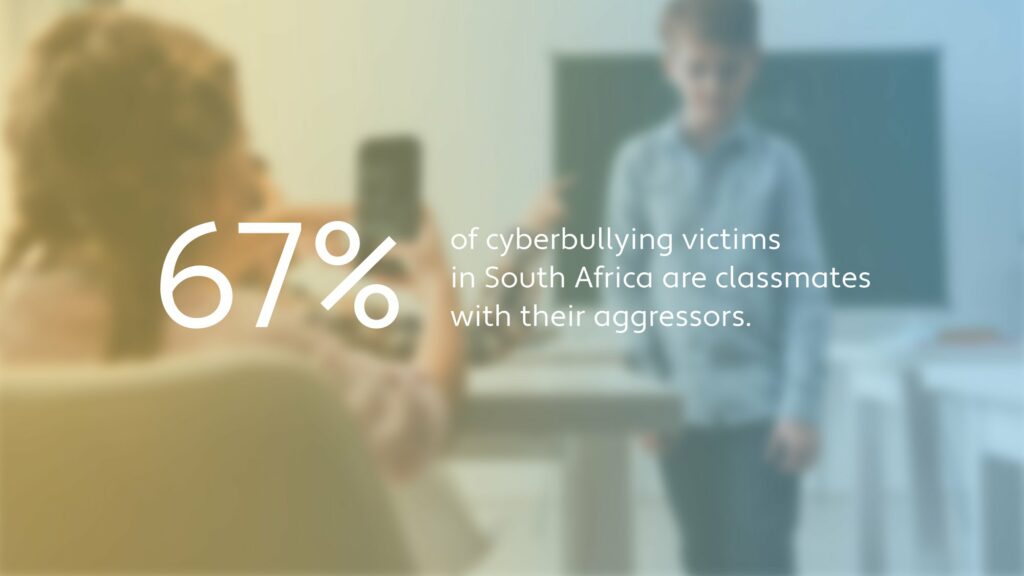Is your child a victim of cyberbullying? Learn more about this digital threat and how to avoid as well as deal with it if it does happen.

No parent wants to learn that their child is being bullied online or off. But forewarned is forearmed, so it’s worth taking the time to dissect what exactly cyberbullying is, what forms it takes and how it relates to more traditional victimisation. With this foundation, you can get out ahead of the problem.
Considering that the Ipsos Global Advisor Cyberbullying study indicates that 54% of South African parents know of a child in their community who has been bullied online, this is not something anyone with an interest in our youth can afford to ignore.

Defining cyberbullying
As the name implies, cyberbullying involves using digital technologies to intimidate, offend, threaten or embarrass the target.
Although there are many ways that cruelty online differs from the old-fashioned version, kids that are harassed online are often also bullied in person. For this reason, the 2020 UNESCO Conference on School Bullying recommends addressing the scourge holistically and proposed redefining the behaviour more broadly.
A bully by any other name is just as cruel?
For almost 50 years, scholars, practitioners and policy makers alike have based their understanding of bullying on the work of Dan Olweus, who defined it as unwanted aggressive behaviour with an implicit or explicit intent to harm that is repeated over time and involves an imbalance of power or strength.
Since 67% of cyberbullying victims in South Africa are classmates with their aggressors, it’s clear that social power relations are a common thread between bullying online and off.
That said, digital technologies change the dynamics:
- Repetition: The Internet never forgets, so even single incidents of harassment can still be reshared and proliferate online. What’s more, kids no longer get a reprieve from the abuse when they go home. Wherever and whenever they connect via computers, smartphones and gaming systems, they are vulnerable. Cyberbullying is much harder to escape than the traditional face-to-face forms.
- Intention: At a digital remove from their victims and frequently cloaked in anonymity, cyberbullies often don’t see the pain they cause. A fact chillingly testified to by the U.S. National Crime Prevention Council’s findings that 81% of youth believe the culprits engage in this online behaviour because they think it’s funny. Surveyed teens appeared unaware of the negative emotional and psychological impact on victims.
If this still feels a bit abstract to you, this brief (and by no means comprehensive) cyberbullying glossary should help you to get a handle on things.
Types of cyberbullying
Cyberbullying is considered a criminal offence in South Africa. Since harassment can escalate, it’s a good idea to teach kids to save evidence of incidents whether they take the form of text, photos or videos in email, social media posts, instant messages or gaming chat channels.
- Cyberstalking This serious form of cyberbullying is characterised by threats and intimidation that make the victim fear for their safety.
- Dissing/spreading rumours: A bully – usually someone who knows your child well – spreads false rumours or stories online that ruin their reputation or relationships.
- Doxing/outing: Broadcasting someone’s personal or sensitive information to a wide digital audience in order to humiliate them.
- Exclusion: A child who doesn’t receive an invitation to participate or isn’t included in group conversations feels rejected.
- Flaming: Hostile, offensive language often including insults and profanity aimed at drawing a response from the subject. Think of Donald Trump’s use of the phrases “Crooked Hillary” and “Sleepy Joe Biden”.
- Fraping: A bully gains access to your child’s social media or other account and posts inappropriate content in their name. While this may be harmless between friends, it can turn ugly when it damages the victim’s reputation.
- Masquerading: Using a fake profile or online identity to bully the victim anonymously or impersonating someone else in order to trick or deceive them.
- Sexting: Whether shared willingly or produced under coercion, explicit images, videos or messages sent to others are easily circulated. In addition, the embarrassment this can cause, soliciting, creating, sharing and possessing indecent pictures of children under 18 is considered child pornography and is illegal in South Africa – even if the minor in question snapped the image themselves.
- Trolling: These kinds of derogatory and offensive posts, comments or content aim to get people riled up, while the bully sits back and watches things go to pieces.
Kids that are tormented by cyberbullies suffer anxiety, fear, depression, low self-esteem, behavioural issues and often struggle academically. Worst of all, victims are twice as likely to consider suicide.
So what do parents need to do to protect your kids and ensure they don’t become perpetrators?

Tips to prevent cyberbullying
The line between cyberbullying victims and aggressors is often a fine one. Victims sometimes go on to harass others as a way of lashing out after being unable to retaliate against the original bully or in an attempt to reassert control, creating a vicious circle.
Dr. Denis Sudkhodolsky, who is an associate professor at the Yale Medicine Child Study Center, explains:
“Bullies feel the negative effects of their behaviour. They don’t know how else to behave and suffer from feelings of confusion, embarrassment and social isolation. Nobody in their lives has explained to them what it means to hurt another person’s feelings.”
It’s precisely this kind of empathy that we need to inculcate in all children so that they treat others with kindness and respect in both the real and virtual worlds.
Cultivating good cyber-citizens
Instilling good netiquette in your children is just as important to their socialisation as more traditional life lessons. That includes encouraging them to be as polite online as they are in person and considering how they would feel if at the receiving end of their comments or content. To do so, they should remember never to post when angry or upset.
The ability to put yourself in others’ shoes is essential to preventing cyberbullying. When digital bystanders encourage or join in the abuse, this fuels the fire, while peers that support victims and call out the bullies can help stamp out the behaviour.
Better safe than sorry
For all that we want our kids to be good cyber-citizens, they need to know to tread with caution online. Cyberbullies aside, they should also be alert to the dangers of predators, scammers and inappropriate content (pornography, violence).
You can help by teaching them some important rules:
- Never share personal information online. That goes for their full names, addresses, telephone numbers, school’s name, parents’ names, credit card numbers or their friends’ personal details.
- Only share Internet passwords with parents. No one else – not even friends! Because a falling out is all it takes to place them at risk.
- Make talking about online activities as ordinary as describing the school day.
- Never post anything online that they wouldn’t want their classmates – or grandmother – to see
While these messages can’t be overemphasised enough, the reality is that kids’ brains and decision-making abilities are still developing. Because they may not be psychologically mature enough to make the right choices, you need to keep just as close an eye on what your child does online as you do on where they go and who they spend time with offline.
For many parents that means clearly communicating that they will monitor the child’s online interactions, media and activities. Parental control hardware and software can also establish guardrails by blocking inappropriate content and websites, limiting screen time, monitoring app use, tracking your child’s location and more.

Digimune offers next-generation solutions to protect the next generation
Digimune offers 360-degree solutions that allow you to balance the need to shield your child from harm with allowing them digital freedoms and learning opportunities.
We’d love to help you raise a happy, healthy and digitally savvy child. Take a look at our range of solutions and feel free to contact with any questions.




